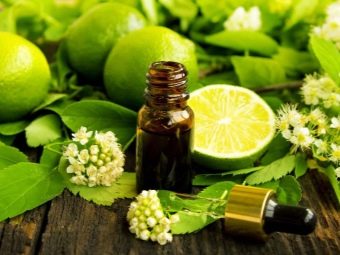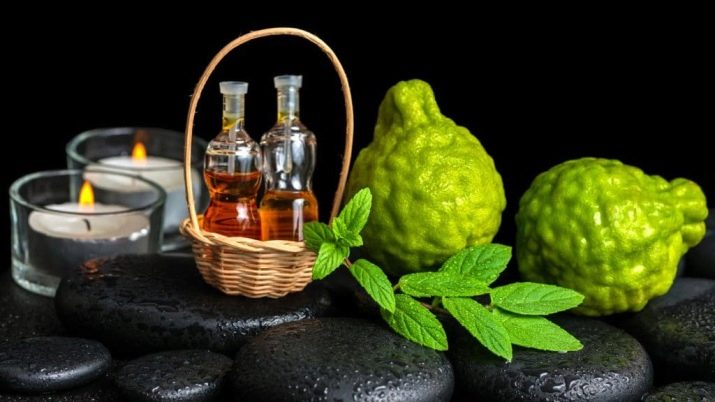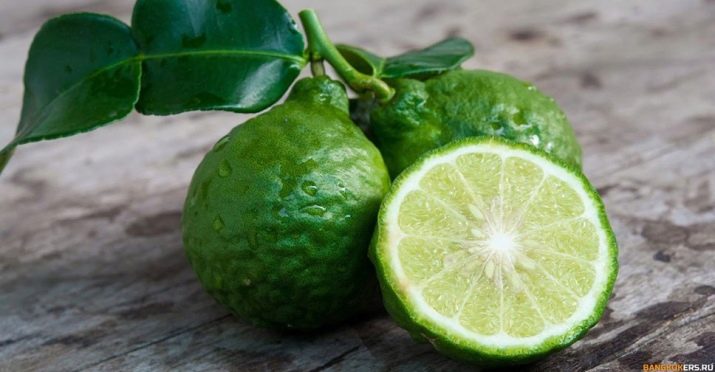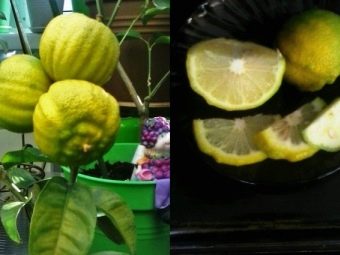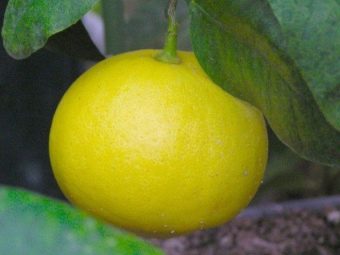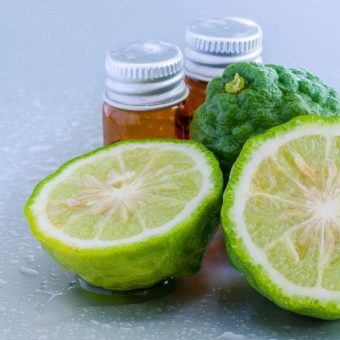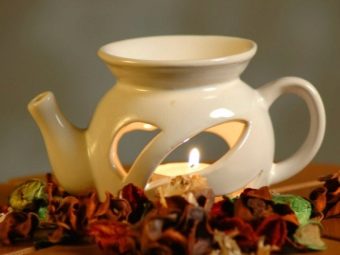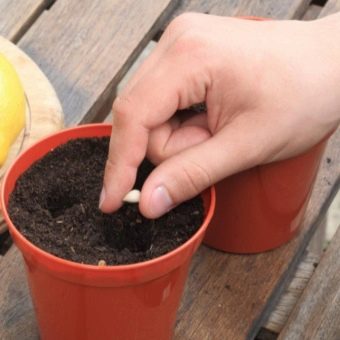Bergamot: what it is, what it looks like and where the fruits are applied?

At the mention of bergamot, everyone immediately remembers their favorite tea with this supplement.Some people think that bergamot is a well-known type of pear, while others confuse it with spicy grass called monard. In fact, this is not one and not the second.
What is it and what does bergamot look like?
There is a perception that bergamot is a separate type of orange, but this is completely wrong. From the position of biology, bergamot appeared by repeatedly crossing lemon (citron) and orange (this is something between pomelo and mandarin). The product was bred in ancient China, although there is a theory that bergamot was the product of a natural mutation of an ordinary orange under the influence of external climatic and natural factors.
According to the description, bergamot is an evergreen plant, which belongs to the citrus of the genus Rutaceae. All fans of oranges and tangerines will not like the fact that the mature fruits of this plant are absolutely inedible - they are too bitter and quite sour.
However, spicy syrups and candied fruits are made from ripe fruits, but their main purpose is to produce fragrant essential oil.
The tree of this culture is medium-sized - its length reaches 5-6 meters, and under favorable growing conditions it can grow up to 10 m. It has a spreading crown and a lot of shoots with prickles that grow up at a pointed angle to the stem. The leaves are green and smell very good: if you rub them a little with your hands, they exude a gentle, pleasant aroma. Fruits visually resemble lemons, have a light yellow-green shade.
How come?
In the countries of the Old World, bergamot was first planted in the small Italian province of Calabria. According to one theory, the plant got its name from the name of the village of Bergamo, near which the fields of culture were equipped, and for some time many called it “Bergamo orange”. But the French first learned how to use the plant; it was in France that perfumers began to use it to create perfumes with a rich aroma.
According to the second version, bergamot was taken into development in Italy, where in one of the men's monasteries in the 17th century. on the basis of fragrant oil obtained from it, an unusual cologne was created. His recipe was kept in secret for a very long time and until the end of the 17th century. no one could solve it, although there were many attempts. This was only possible for the Cologne pharmacist, it was he who at the turn of the century introduced Eau De Cologne eau de toilette with a hint of bergamot to consumers, which immediately conquered Europe.
As you can see, the history of human use of bergamot originates from the creation of eau de parfum, in this area the plant is widely used in our day. To be more precise, in cosmetology and perfumery branches, bergamot oil is used, which is obtained from leaves, rough peel of fruits and even green young shoots of this evergreen plant.
Bergamot has light anti-inflammatory properties, so that at a time when no one had heard about antibiotics, the plant was often used in inflammatory infections. A balsam was cooked from it, which perfectly relieved the irritation on the skin, and in case of heavy injuries, the pulp of a mature fetus was attached to the affected area. Today, bergamot is also very often used in medicine: it is included in the composition of healing teas for colds and viruses, as well as to strengthen the body's defenses.
Bergamot has a whole range of beneficial effects: it reduces spasms and has a mild sedative effect, and besides, it improves the processes of digestion and increases libido in men and women. External application of bergamot is no less effective - a decoction of fruits and leaves of the plant wipe the skin with a weakened tone, gore, contaminated pores and pigment spots.
Well, in addition to this, tea with a delicate, exquisite taste and pleasant aroma will help to relax after a hard day, relieve from strong physical and mental fatigue and relieve mental stress.
Where and how to grow?
As mentioned above, initially bergamot began to be cultivated in Italy and used for the production of perfumed products. Perhaps its use would have been limited to this if in the XVIII century the inhabitants of foggy Albion did not find a new use for it: they began to add the leaves and fruits of this unusual plant to tea, and this was how the world-famous Earl gray was created.
By the way, there is a legend that it happened quite by accident. Allegedly, the English sailors were carrying on their ship dishes with bergamot oil and a batch of black tea. During the journey, a storm broke out, as a result of which the vessels with oil broke, and their contents fell into the bags with tea leaves and completely soaked the tea.
The merchants were very upset, because the goods were expensive, and they decided to try the tea in the hope that its taste did not change much. They were extremely surprised that the brewed drink was delicate and very delicious. Whether it was or not is unknown, but since then the plant has become one of the most cultivated in the world.
However, the cultivation of bergamot is significantly limited, mainly it can be found in the Italian provinces, and in this area it is even a symbol of the regions. In addition, bergamot is cultivated on the shores of the Mediterranean Sea - in Spain, Greece and France, this is where the climate and soil structure are most favorable for it. This plant can often be found on the fields of the South American contingent - in Argentina, as well as Brazil. Very similar culture grows in Thailand, and more recently, the plant began to plant in the US state of Georgia.
Features of the fetus
The fruits of bergamot are considered the most valuable, in terms of the concentration of essential oils, part of a citrus plant. They may have a different size, they are pear-shaped or spherical. In the cut, the pulp resembles an unripe lemon and lime.
Fruits and young leaves of bergamot differ in composition rich in vitamins and mineral components. There is a high concentration of fatty soluble and insoluble acids, various type B vitamins, and retinol, folic acid, necessary for the body of ascorbic and nicotinic acids. The product is rich in various trace elements: there are large reserves of sodium, calcium, magnesium, phosphorus, as well as selenium and copper.
Bergamot oil is squeezed out of the coarse rind of fruits, and their content in it is rather small - no more than 3%. The main component of the essential oil is L-linalyl acetate, the content of which is 35-50%, as well as a lot of citral, A-pinene, camphene and bergapten. The husks also contain P-karyofillen and D-limonene and many other components.
Bergamot fruits are quite low in calories. 100 g of the product contains only 36 kilocalories, so it can be recommended for inclusion in the diet, however, in practice, this has not yet been done.
Bergamot fruits have a delicate, but cold smell with fresh spicy notes and a light balsamic tinge. This fragrance is considered to be a natural pheromone that can attract people of the opposite sex, and this effect occurs at a subconscious level.
Varieties
Bergamot is a plant that many mistakenly call Monarda and secrete several of its main varieties.
- Double - This plant is cultivated in the middle zone. Flowering lasts a little more than a month in the second half of summer. Plants of this type are quite unpretentious and hardy, prefer fertile soils, dry soil and well-lit areas. At one place, the monard can grow for quite a long time, but as a rule, by the age of three it grows so that the branches begin to interfere with normal fruiting, so the culture requires renewal.
- Citrus citrus deserves special mention. The fruits and leaves of this plant have a delicate lemon flavor, are considered an excellent addition to tea.However, monard and bergamot are different plants. Monarda is an ornamental grassy shrub, and bergamot is an evergreen tree.
The most popular varieties of bergamot include the following types.
- "Malarose" - Bergamot, the fruits of which can have various shapes: from spherical to flattened.
- "Toruloza" - distinguished by fruits with longitudinal ribbing.
- But the most common common bergamot, this group includes several varieties: Femminello, Castagnaro and Inserto, the latter being a hybrid of the first two. Castagnaro is the largest fruit in size; however, Femminello has a much higher yield. In addition, "Castagnaro" fruits contain less essential oils, so the grade is less often used for the production of perfumery products. The Calabrian variety is also very popular.
Application
The most widely known way to use bergamot is the production of essential oils, which are fairly easy to obtain. This can be done even with your own hands - when pressing on the peel with squeezing movements, drops of oily liquid are already released. The smell of bergamot oil is truly amazing: at first glance, it is floral, but at the same time it contains notes of orange and mandarin, however, they are not sour, but very fragrant and sweetish. The oil, squeezed out by hand, is considered to be the most expensive: in order to produce 900 ml of the product, it is necessary to process the peel of 1000-1500 ripe fruits.
The oil is commonly used to create perfume compositions, most often it is combined with the marc of such fragrant plants as neroli, as well as orange and rosemary. The creators of the perfume incredibly appreciate its fruit and floral scent. It invigorates and has a refreshing effect, and besides, contributes to improving mood - this is not surprising, because the fruits of bergamot can act directly on the hypothalamus, which is responsible for emotions in the human body.
However, the scope of its use does not end there: The product has been used in medicine to get rid of acne, various rashes, and also to reduce itching after unpleasant bites of stinging insects. This oil is very effective for a significant improvement in the appearance of hair and the condition of the scalp. It is proven that bergamot oil can relieve anxiety and fatigue, especially if a person is in an irritated state. His psyche normalizes, personal harmony rises and a strong feeling of positive and spiritual comfort is formed.
Due to this effect, psychologists and psychiatrists believe that aromatherapy with this oil has good performance. It is proved that this significantly improves the concentration of attention, clarity of thinking, and creative features develop. Procedures can be carried out in two ways - either using an aroma lamp, or simply inhaling the fragrance from the bottle. By the way, it also relieves a headache well.
Those who can not wake up in the morning for a long time should take a douche with a tonic containing natural bergamot oil. If you are worried about pain in the neck - it makes sense to massage it with 100% grape seed squeezing, to which a couple of drops of bergamot oil are infused. When conducting a massage of the abdomen with this product, it is possible to significantly improve digestion and increase the appetite - this is especially important for exhausted people who have suffered a long protracted illness. Oil can help with severe colds, coughs, and frequent runny nose - it makes breathing easier and helps to cleanse the sinuses.
The leaves and fruits of the spicy plant are included in the composition of various dietary supplements that contribute to the normalization of health. Such products heal strong wounds, strengthen defenses, have a slight diuretic effect and deodorize a little.In addition, drinks with leaves and citrus fruits can significantly increase lactation.
And, of course, the product is used to create fragrant and tasty teas, but in culinary the fruits of this tree did not take root. They have a bitter-sour taste, so it’s almost impossible to cook a tasty dish from them. Although in some countries still produce candied fruit, marshmallow and even sweet marmalade.
Is it possible to grow at home?
If desired, bergamot can be grown at home. Usually this is done with the use of seeds, by analogy with oranges and lemons. For cultivation it is better to use a special soil for citrus, however, the soil mixture of humus and sand is also suitable.
Seeds deepen by 1 cm. Water the young plant as the soil dries. Germination is quite slow - the first shoots appear only after a month.
After the three true leaves appear, you can pick and sit down in separate pots. Home citrus responds well to competent care, and even at home can give a good harvest. It is very important to choose the right place in the house - the plant needs lit areas, so it is best to place the pots on the windows facing the south-east and east sides.
However, direct sunlight that has passed through the glass can burn the leaves. To prevent this, the window should be shaded with light tulle after 12 noon.
If the pots are placed on the north windows, the plant will need additional lighting. The total duration of insolation should be 9-11 hours. Bergamot prefers room temperatures. For its growth and development it is optimal to maintain the degree of heating of the room at a level of 20-24 degrees, the minimum allowable temperature is 15 degrees, however, in this case the probability of flowering and fruiting is small.
And, of course, like any plant, Bergamot needs feeding. They should be carried out from February to September, during the period of active growth, ready-made preparations for citrus fruits with the addition of potassium phosphate dressing are best suited.
See more on the properties of bergamot in the next video.



